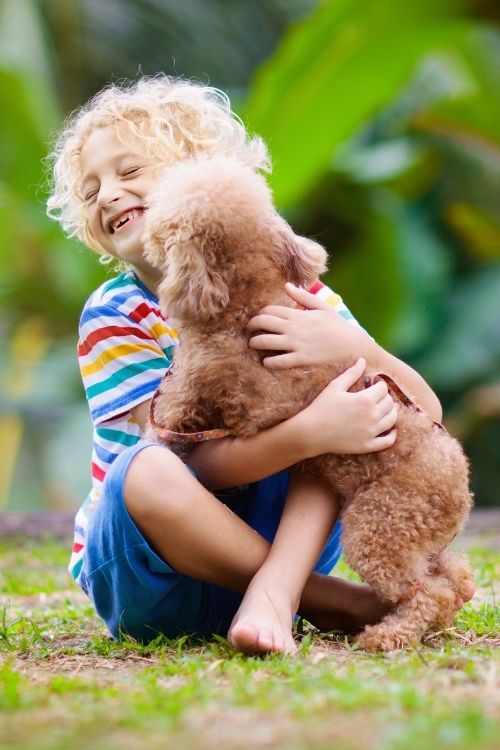Most dogs are predictable, but if one day they aren’t?
You’re at home with your kids. Your toddler’s chasing bubbles and your dog happily waving its tail nearby. It’s perfect, right? But then, out of nowhere, the dog snaps. What do you do?
Let me start by saying I love animals. I’ve raised dogs, fostered cats, and even been that guy who stops to pet every dog I see on walks.
But here’s the thing: animals are still animals. They can’t tell you when they’re feeling off, in pain, or overwhelmed. And sometimes, that unpredictability can become a problem, especially when kids are involved.

Why Do Dogs Bite?
Dogs don’t bite out of the blue—there’s always a reason behind it. So, what made your dog lash out?
Maybe they were scared or anxious. Was your child hugging them too tightly, pulling their tail, or grabbing their ears? Dogs have boundaries, just like we do, and sometimes kids cross them without realizing it.
It could also be because your dog is in pain or not feeling well. When dogs are sick or injured, they can be extra sensitive, and even a gentle touch might feel unbearable.
Or maybe your dog felt threatened. Dogs are naturally protective, and if your child gets too close to their food, toys, or favorite spot, they might react to guard what they consider theirs.
Think about the context: what was happening right before the bite? Once you know the cause, you’ll have a better idea of what to do next.
What to Do Immediately if Your Dog Bites Your Child
Okay, so it happened. Your dog bit your child. Now what?
First, you need to make sure your child is safe. Separate your dog from your child right away. It doesn’t have to be dramatic—just calmly move your child to another room or put the dog in a crate or secure space. Your priority at the moment is to stop any further harm from happening.
Next, check your child’s injury. Is it just a small scratch or nip, or is it more serious? If it’s a minor injury, wash the area with soap and warm water to prevent infection. For deeper bites or if you see broken skin, you may need to apply pressure to stop the bleeding and then take your child to a doctor for a professional evaluation. Even small bites can lead to infection, so don’t brush it off.
While you’re tending to your child, keep in mind that yelling at your dog or acting aggressively toward them won’t help. It’s natural to feel upset in the moment, but your dog is probably already stressed or scared, and reacting harshly could make things worse. Focus on staying calm and handling the situation step by step.
How to Prevent It From Happening Again
Once a dog bites, it can bite again, here’re is what I’ve learned that can work to stop that from happening.
Always Supervise Interactions
Leaving a kid and a dog alone together is like tossing unpredictable buddies into the same room without a referee! Even if your dog is usually gentle, accidents can happen in a blink. Always stick around when your dog and kids are together so you can step in if something feels off.
Teach Your Kids How to Treat Dogs
Kids can get a little wild with pets. Pulling ears, climbing on backs, or getting all up in a dog’s face seems harmless to them, but it can overwhelm or scare your dog.
Take a few moments to teach your kids some dog basics: approach them slowly, give them gentle pets, and respect their space. Got a dog bed or crate? Make sure your kids know it’s off-limits—it’s your dog’s chill zone.
Work on Your Dog’s Training
Training isn’t just for puppies—it’s for every dog. If your dog isn’t used to kids, start small. Reward calm behavior and help them get comfortable with the chaos kids can bring. Need some extra guidance? Here’s a video with helpful tips—I’m sure you’ll pick up one or two things about dog training from it!
And if you’re not sure where to start? Call in the pros, they can help build a safer relationship between your dog and your family.
Rule Out Health Issues
Could your dog be in pain? Dogs can’t tell us when something’s wrong, but a trip to the vet might uncover an injury or health problem making them irritable..
Set Boundaries
Sometimes, your dog just needs space, like us.
Use baby gates or create “no-go zones” in your home so your dog has a spot to retreat when they need a break from the noise.
Seek Professional Help
If you’ve tried all you can and it won’t help, it’s time to call in the pros. A certified dog trainer or behaviorist can help address the problem in a way that’s safe and effective.
And if the situation feels unmanageable or dangerous, you might need to make a tough decision about whether your home is the right fit for your dog.
It’s heartbreaking to consider, but keeping your family safe always comes first.